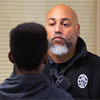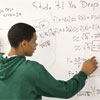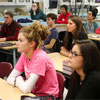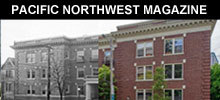Originally published November 29, 2014 at 10:34 PM | Page modified December 1, 2014 at 4:01 PM
UW, WSU give future engineers a ‘redshirt season’
In an idea borrowed from college athletics, the University of Washington and Washington State boost promising engineering students — many of them women and minorities — with an extra year of academic work.
Seattle Times higher education reporter

Education Lab is a Seattle Times project that spotlights promising approaches to some of the most persistent challenges in public education. It is produced in partnership with the Solutions Journalism Network, a New York-based nonprofit that works to spread the practice of solutions-oriented journalism. Education Lab is funded by a grant from the Bill & Melinda Gates Foundation. Find out more.
Academic Red Shirt programs in engineering
All three programs — one in Colorado and two in Washington state — include an intensive first year of academic work using small-group instruction, mentors and academic tutoring. Students who maintain a certain grade-point average are guaranteed admission into each school’s engineering programs.
University of Colorado at Boulder:
• Started in 2009
• Accepts roughly 30 students each year
• Initially funded with grant from National Science Foundation (NSF); now financed from university funds
University of Washington:
• Started in 2013
• Accepts roughly 30 students each year
• Currently funded with a 5-year, $969,975 grant from the NSF, which includes money to evaluate the success of the program at UW and WSU
Washington State University:
• Started in 2013
• Accepts roughly 30 students each year
• Currently funded with a 5-year, $700,000 grant from the NSF
Stories in the series
Suspending kids doesn't fix bad behavior; what schools are trying instead
Published December 2014
It stands to reason: Kick troubled students out of school and they often come back even worse. The Kent School District is trying to tackle this national problem by overhauling the way it handles discipline. But its answers spark even more questions. Read the story →
UW gives future engineers a ‘redshirt season’
Published November 2014
In an idea borrowed from college athletics, the University of Washington boosts promising engineering students — many of them women and minorities — with an extra year of academic work. Read the story →
Does class size matter? Research reveals surprises
Published October 2014
The most obvious reason for why smaller classes work — that teachers give students better, more-tailored instruction — probably isn’t the reason why achievement goes up, studies have found. Read the story →
More about Education Lab
![]()
When she got the letter in summer 2013, Courtney Seto thought it sounded too good to be true.
A free program that offered automatic acceptance into the University of Washington’s engineering school? Did everyone get this letter?
Seto had already been accepted to the UW as an incoming freshman, but she expected to apply to the College of Engineering at the end of her sophomore year, competing against 1,000 other UW students, of which only about 55 percent get in.
So Seto set the letter aside — until somebody at the UW called and convinced her it was for real.
Now in her sophomore year, Seto has already been accepted into the industrial engineering department, thanks to the UW’s State Academic Red Shirt program, or STARS.
In an idea borrowed from college athletics called redshirting, STARS enrolls promising engineering students — many of them women and minorities — to give them an additional year of collegiate academic work before they’re ready for the big time. A similar program is in its second year at Washington State University.
Seto was a perfect candidate.
She was good at math and science, did well on the national Advanced Placement calculus exam and graduated in the top 10 percent of her class at her high school in Vancouver, Wash.
But her school didn’t have strong math and science departments, and the students’ standardized test scores were low. Because she was so bright, Seto didn’t have much trouble making A’s.
Students like her often don’t make the cut for UW’s engineering schools. Because engineering has become so competitive, the top candidates tend to be from high schools with high standardized-test scores and rigorous college-level courses. Those schools also usually have a wealth of extracurricular activities where students further hone their interest in the sciences.
In high school, Seto took an aptitude test that suggested industrial engineering as a possible career, but she had never even met an engineer.
As a woman, she met STARS’ goal of bringing a little more balance to engineering programs, which at the UW and elsewhere are dominated by white and Asian men from privileged backgrounds.
In 2014, only about 23 percent of the UW students who received bachelor’s degrees in engineering were women. And only about 7 percent of the UW’s 2014 graduates were underrepresented minorities — African-American, Hispanic/Latino, Native American or Hawaiian students.
The lack of diversity in computer science and engineering has grabbed headlines in recent months, and most tech companies acknowledge they need to do better. But the problem also tracks back to the universities, where the competition for a slot in engineering is ruthless.
Without a program like STARS, funded with a grant from the National Science Foundation, students like Seto have very little time to catch up to better-prepared peers.
With STARS, she has five years to earn her bachelor’s in engineering, spending the first on prep work aimed at putting her on equal footing with those from more privileged backgrounds.
Though it’s early yet, the program seems to be working.
First test a big one
A week before first-quarter midterms at the University of Washington this fall, 15 STARS students clustered around whiteboards in Loew Hall, covering the boards with inky equations.
Their mingled voices rose and fell as they worked out problems together, out loud, puzzling through the logic of calculus.
Delta-A equals one times A, and divide by 100, and that equals pi R squared ... Delta R is just basically equal to 100 F ... That would be the prime of X ... So, then I just plugged in R ...
They are working at a level some of them never reached in high school, even if they did well in math. One reason engineering programs lack diversity, STARS directors say, is that the quality of math instruction at Washington high schools is wildly uneven, with the weaker programs often in low-income schools.
For weeks now, professors and instructors had been warning these students, many of whom are the first in their families to attend college, that this first midterm was going to be really difficult — a test of their determination to do the hard work it takes to become engineers.
That fact doesn’t always sink in until after the test.
Last year, for example, Seto thought her AP calculus work in high school had set her up well for engineering, so she was surprised to be placed in a precalculus class as a freshman. Still, she and many other students in STARS failed the first midterm.
She quickly realized that college math was going to require a different kind of intensity.
“There were a lot of times when it got really hard, and then you just look at your fellow STARS peers, and they’re going through the same thing as you,” Seto said. “You bond over that mutual struggle.”
Because the major is so competitive, a low score on a math midterm can be enough to torpedo a student’s dream of becoming an engineer.
“There’s so much weeding out,” said Eve Riskin, associate dean of diversity and access for the UW College of Engineering. “The system isn’t patient enough, and that’s unfortunate.”
By the end of the first year of STARS, 21 of 30 students had earned at least a 3.0 grade-point average, the minimum needed to gain entry into engineering through STARS. Outside of STARS, students who are accepted into engineering have grade-point averages of 3.37 to 3.78.
Pioneering program
The academic redshirt program was first pioneered at the University of Colorado (CU) at Boulder six years ago.
The learning curve was steep. Ten students out of the original cohort of 16 did not finish the program.
After the first two years, the university retooled it significantly.
CU-Boulder became more careful about how it selected students, making sure they were up to the challenge, said Tanya Ennis, Engineering GoldShirt director. (The university uses “gold shirt” instead of “red shirt” because gold is one of the school’s colors.)
It required all students to live on campus for the first two years. It revamped a precalculus course to better prepare students for the first year of college calculus. The university offered extra scholarship money so students didn’t have to work while going through school, and offered financial incentives for those who reached a certain GPA.
Three years later, 75 percent of students stayed in the program, and last year 80 percent did.
Washington’s schools have benefited from CU-Boulder’s insights about making a big school feel small, teaching math intensively the first year, and helping students understand what engineering is all about.
They’ve also drawn on research that makes it clear that navigating college requires much more than just doing well on a calculus test.
That research shows that low-income and first-generation students are much more likely to drop out of college than students who come from better-off families — even when academic ability, at least as measured by standardized test scores, is the same.
“You need to know how to navigate the system,” said Sonya Cunningham, the director of the UW STARS program, and herself the first in her family to go to college.
Some first-generation students want to go home every weekend to study at the kitchen table, like they did in high school. But they will do much better if they stay on campus, surrounded by students studying the same material, and where help is available if they hit a snag, Cunningham said.
The challenges can be further magnified at a big school like the UW’s Seattle campus, which has the 12th-largest enrollment of any college campus in the country.
To make college feel smaller, STARS programs at UW and WSU group about 30 students together in the same classes. At the UW, students are also required to live on campus the first year.
Students say it works.
“We did all of our studying together ... we went to the same classes,” Seto said. “We got to know each other pretty well.”
In their first year, students take classes in study skills and time management as well as math and chemistry.
Sophomore Melina Soto, the first in her family to go to college, has learned to do her work early so she can get help if she is stumped. And she’s found it especially helpful to go to the UW’s Engineering Academic Center, where study groups, often made up of students from diverse backgrounds, puzzle through difficult assignments.
Seeking right students
The STARS programs in Washington have had some bumps, too.
In summer 2013, the first year STARS opened at UW and WSU, the programs scrambled to find students. WSU, in particular, had less time to find them because, as a school on the semester system, its classes start a month before the UW’s.
A significant number of WSU’s first cohort of 30 students weren’t academically strong enough and just stopped coming to class, said WSU STARS director Jeremy Kingma.
This fall, WSU and UW screened applicants with personality tests and essay questions designed to show which students were most likely to persevere in the face of obstacles.
WSU looks for students who have a “growth mindset,” an idea developed by Stanford psychology professor Carol Dweck that emphasizes effort over intelligence or talent.
“It’s not a question of how smart you are; it’s a question of how hard you’re willing to work,” said John Schneider, associate dean for undergraduate programs in WSU’s Voiland College of Engineering and Architecture.
So far this year, only one STARS student has dropped out of the UW program, and none have dropped out at WSU.
The programs won’t yet make a big change in the racial or gender makeup of their universities’ engineering programs. The UW College of Engineering, for example, accepted 985 students last year — and just 21 of them were from STARS.
But the program could be expanded if it proves successful, said Riskin, the associate dean of diversity and access for the UW’s engineering college.
“Research shows that we lose women and minorities from engineering because they feel like they don’t belong,” she said.
“I could write pages of the times I was made to feel like I didn’t belong, just for being a woman — and I came from a family where both parents had gone to college,” she added. “So the STARS community gives our students the sense of belonging they need.”
Katherine Long: 206-464-2291 or klong@seattletimes.com. On Twitter @katherinelong
 Four weeks for 99 cents of unlimited digital access to The Seattle Times. Try it now!
Four weeks for 99 cents of unlimited digital access to The Seattle Times. Try it now!
















